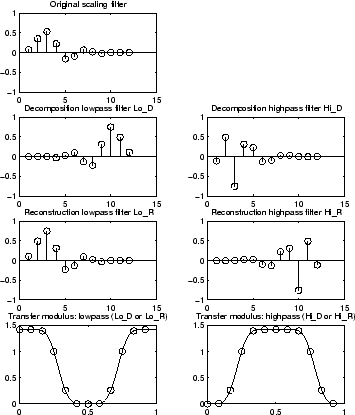orthfilt
Orthogonal wavelet filter set
Syntax
[Lo_D,Hi_D,Lo_R,Hi_R] = orthfilt(W)
Description
[Lo_D,Hi_D,Lo_R,Hi_R] = orthfilt( computes
the four filters associated with the scaling filter W)W corresponding
to a wavelet:
Lo_D | Decomposition low-pass filter |
Hi_D | Decomposition high-pass filter |
Lo_R | Reconstruction low-pass filter |
Hi_R | Reconstruction high-pass filter |
For an orthogonal wavelet, in the multiresolution framework, we start with the scaling function ϕ and the wavelet function ψ. One of the fundamental relations is the twin-scale relation:
All the filters used in dwt and idwt are intimately related to the sequence . Clearly if ϕ is compactly
supported, the sequence (wn)
is finite and can be viewed as a FIR filter. The scaling filter W is
A low-pass FIR filter
Of length 2N
Of sum 1
Of norm

For example, for the db3 scaling filter,
load db3
db3
db3 =
0.2352 0.5706 0.3252 -0.0955 -0.0604 0.0249
sum(db3)
ans =
1.000
norm(db3)
ans =
0.7071
From filter W, we define four FIR
filters, of length 2N and norm 1, organized as follows:
Filters | Low-Pass | High-Pass |
|---|---|---|
Decomposition | Lo_D | Hi_D |
Reconstruction | Lo_R | Hi_R |
The four filters are computed using the following scheme:

where qmf is such that Hi_R and Lo_R are
quadrature mirror filters (i.e., Hi_R(k) = (-1)kLo_R(2N
+ 1 - k), for k = 1, 2, Ä, 2N),
and where wrev flips the filter coefficients. So Hi_D and Lo_D are
also quadrature mirror filters. The computation of these filters is
performed using orthfilt.
Examples
% Load scaling filter.
load db8; w = db8;
subplot(421); stem(w);
title('Original scaling filter');
% Compute the four filters.
[Lo_D,Hi_D,Lo_R,Hi_R] = orthfilt(w);
subplot(423); stem(Lo_D);
title('Decomposition low-pass filter');
subplot(424); stem(Hi_D);
title('Decomposition high-pass filter');
subplot(425); stem(Lo_R);
title('Reconstruction low-pass filter');
subplot(426); stem(Hi_R);
title('Reconstruction high-pass filter');
% Check for orthonormality.
df = [Lo_D;Hi_D];
rf = [Lo_R;Hi_R];
id = df*df'
id =
1.0000 0
0 1.0000
id = rf*rf'
id =
1.0000 0
0 1.0000
% Check for orthogonality by dyadic translation, for example:
df = [Lo_D 0 0;Hi_D 0 0];
dft = [0 0 Lo_D; 0 0 Hi_D];
zer = df*dft'
zer =
1.0e-12 *
-0.1883 0.0000
-0.0000 -0.1883
% High- and low-frequency illustration.
fftld = fft(Lo_D); ffthd = fft(Hi_D);
freq = [1:length(Lo_D)]/length(Lo_D);
subplot(427); plot(freq,abs(fftld));
title('Transfer modulus: low-pass');
subplot(428); plot(freq,abs(ffthd));
title('Transfer modulus: high-pass')
% Editing some graphical properties,
% the following figure is generated.

References
Daubechies, I. (1992), Ten lectures on wavelets, CBMS-NSF conference series in applied mathematics, SIAM Ed. pp. 117–119, 137, 152.